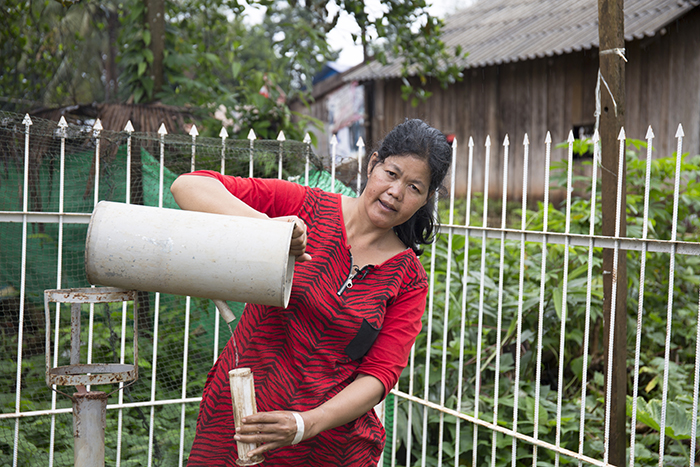Each and every day for the past two years, Ms. Let has been manually checking a simple rain gauge installed at the end of her backyard, logging rainfall data and reporting it the provincial authorities. A new automatic weather station in her backyard -- one of 54 installed by UNDP across the country -- makes her job easier. Yet her commitment, and that of others like her, remains indispensable to ensuring communities receive early warning of adverse weather © Samruol Im/UNDP Cambodia
By Muhibuddin Usamah, Early Warning Systems Project Manager, and Nick Beresford, Resident Representative, UNDP Cambodia
When you think about measuring climate change or forecasting the next big flood or drought, one might assume high-tech equipment being part of the process. Certainly, it is vital. Yet technology only forms part of the equation -- equally crucial are people. Take for example Oak Let, a civil servant with the provincial government of Koh Kong, Cambodia, who until recently relied on the most simple of instruments to measure the weather for her community.
If you were to stroll by her home in the morning or the afternoon, you might catch a glimpse of her in the backyard. Because every day for over a decade she has followed a singular routine: getting out of her one-room wooden home and into her backyard ringed by durian plantations where she checks water levels.
In the yard, sits a container that gathers rainwater, which Ms. Let pours into a beaker, to measure the amount of precipitation. Twice a day, she records the level in a logbook, then reports the information to her counterparts in the Ministry of Water Resources.
She and many other local level civil servants are the unsung heroes of Cambodia’s struggle against the climate crisis and disaster management. Using her data, the Royal Government has been creating models that can give famers and their families the essential information needed to protect lives and safeguard livelihoods.
When we met Oak Let last year, we were in the process of installing one of 54 new meteorological and hydrological stations across Cambodia. The stations will provide real-time data on water level, rain, and temperature.
Meanwhile, in the capital Phnom Penh, the Ministry of Water Resources and Meteorology, working with UNDP and with support from Global Environment Facility-Least Developed Countries Fund, is collating and modelling data to make more accurate and longer-range forecasts. These can be made public and will provide essential information to farmers, allowing them to make better informed decisions about what to plant and when to plant it. For a farming family, it can make a crucial difference between making a good income or falling into poverty.
This information links to analysis of various satellite data sets that can be combined to predict weather and forecast climate. Not only can farming communities use these forecasts, but insurance companies can also use the data for crop insurance and other related products.
The better the information, the lower the risk of error and the greater opportunity to price such insurance products more competitively, at levels farmers can afford. While this is still a work in progress, it is part of the change we need for subsistence farmers to become more successful agri-business owners, with the financial and other products they need.
The availability of real-time data needs builds the future historical data for climate analysis. Cambodia hosts a Disaster Damage & Loss Information System (CamDi) database, which records and houses damages and losses of past disasters. Such a database is instrumental in developing climate projections that are important for risk reduction planning and adaptation to changing climate.
Now that the country has a set of sophisticated weather stations, it may appear that there is no need for Ms. Oak Let’s services. This is far from the truth. One issue we encountered in Koh Kong province was where to put the weather station. That was resolved by Oak Let who offered for it to be placed on her land, at the back of her property. In several other provinces we found equally dedicated local leaders like Oak Let, who provided their own land for weather stations. We knew the equipment was in good hands.
Building resilient climate infrastructure does require high tech equipment, satellite links, and real time transmission of data. But like any good piece of development work it also needs to connect with and receive the expertise and care of community leaders and local heroes. That’s a powerful and winning combination.



